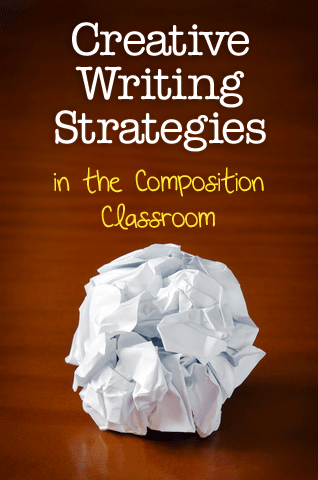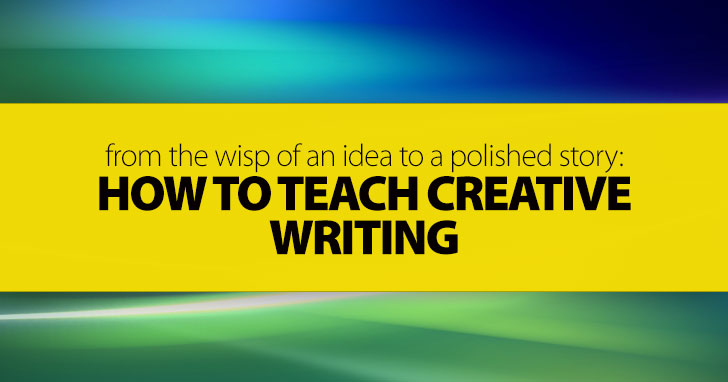Creative Writing Strategies in the Composition Classroom


And indeed even writers, especially novice ones, seem to think that there is some shortage of writing ideas, and that they are almost a capital good—in short supply, hard to find and prone to being “stolen.” However, ideas can’t really be “stolen” as they can’t be copyrighted and are not really owned by anyone—only the final product that sprang from the idea can be. However, this is fine as ideas are actually everywhere, waiting to be transformed by the creative writer into a story or article.

Ideas can be found in everyday life. A student in a creative writing class said to me once that she must have led a sheltered life because she had no earth-shaking event to write about. A story doesn’t have to be earth-shaking; in fact, often the best stories really are about quieter moments in our lives.

I recently structured an entire story around one character saying, “This isn’t about blame.” (A common way to redirect a conversation that is going too much into the area of, well, blame.) The other character immediately responds that it is indeed about blame and that the other speaker, specifically, is the one to blame in this issue. This evolved into a whole story eventually on the theme of blame. Pay attention to how people speak, their dialects, idiosyncrasies, the topics they engage in and how they interact with others. This is fertile ground for writing.
Years ago, I read a news article about a man who disappeared after his car broke down. He ended the phone call to the friend he was meeting for lunch with “I’ll get there when I get there.” He never got there, and it was widely assumed that he had been the victim of violence, perhaps robbery, perhaps had been kidnapped and killed, and his body would turn up in the river or elsewhere. This didn’t happen, but the man himself turned up a year later, alive and well, with the explanation that it had been such a bad day that the car breaking down had been the last straw. This was so fascinating to me—this ability to cut ties and not look back—that I recently wrote a story based on the event—with crucial elements, down to the protagonist’s gender, changed.
What issues do you find yourself thinking about, even obsessing about? These might include issues of identity, family relationships and roles within them, the quirks of contemporary culture, or cross-cultural friendships. If you spend significant time thinking about an issue, the chances are you have something to say on it.

Go to traditional story structure: something happening in the first act, getting complicated in the second and reaching some kind of climax, and then resolving itself in the last act. See how your idea fits into this structure. Try outlining the different events and scenes in your story into this very rough outline of beginning, middle and end. If I begin with the conversation about blame, for example, the middle part has to heighten this issue, complicate the initial concern with more problems that will be blamed on others, and then some crisis moment with release of the tension and sorting out of the problem at the end, with the parties either accepting or forgiving the other of blame.
Is your story a romance, a mystery, or a horror story? Each suggests its own structure and conventions. If you are writing romance, for example, there generally has to be a male and female “lead” who will somehow clash during the course of the story and reunite by the end. A mystery dictates beginning with a crime and the solving the crime, often by a protagonist gathering clues and working backward to determine what happened. The story of the owner of the broken-down car, for example, would probably start with the detective examining the car, then talking with the friend who the “victim” last talked to, and working backward from there, tracing the “victim’s” movements of his last day before arriving at some solution to the “crime.” A horror story will demand, usually, a heightening of suspense throughout to some shocking discovery at the end. The conventions of the genre itself can give ideas for developing a story.
A short story is really a series of dramatic scenes connected with some exposition and description. In my story about the couple arguing over “blame,” for example, there would be a dramatic first scene in which the whole issue is raised--what happened and who is being blamed. There should probably then be some exposition filling in the couple’s background and their current place, the setting, before moving into another scene between the two main characters where the initial concern about blame is complicated, and so forth. In this way, a first draft is developed.
After a first draft is completed, it’s time for revision. Some things to consider: is the point-of-view consistent? If we start by seeing the story unfold from the detective’s point of view, for example, it should probably stay in that point of view, not switch to the victim’s unless for a very good reason. Is the verb tense consistent, or does it jump from past to present tense? It is acceptable, generally, to tell a story in either past or present, but it should stay consistent. Are there enough details and development to connect to the reader and pull her into the story? Is it organized well: are the transitions from place to place and from scene to scene and across a timeline clear, or is it confusing and unclear?
Check conventions such as spelling, punctuation, capitalization, and consistency of places and names. Read the story aloud to check how the dialogue sounds and how smoothly the story flows. If you start stumbling at some point, it might indicate a problem.
However, it is very rewarding when an audience reads the final draft and reacts with pleasure at its craft.